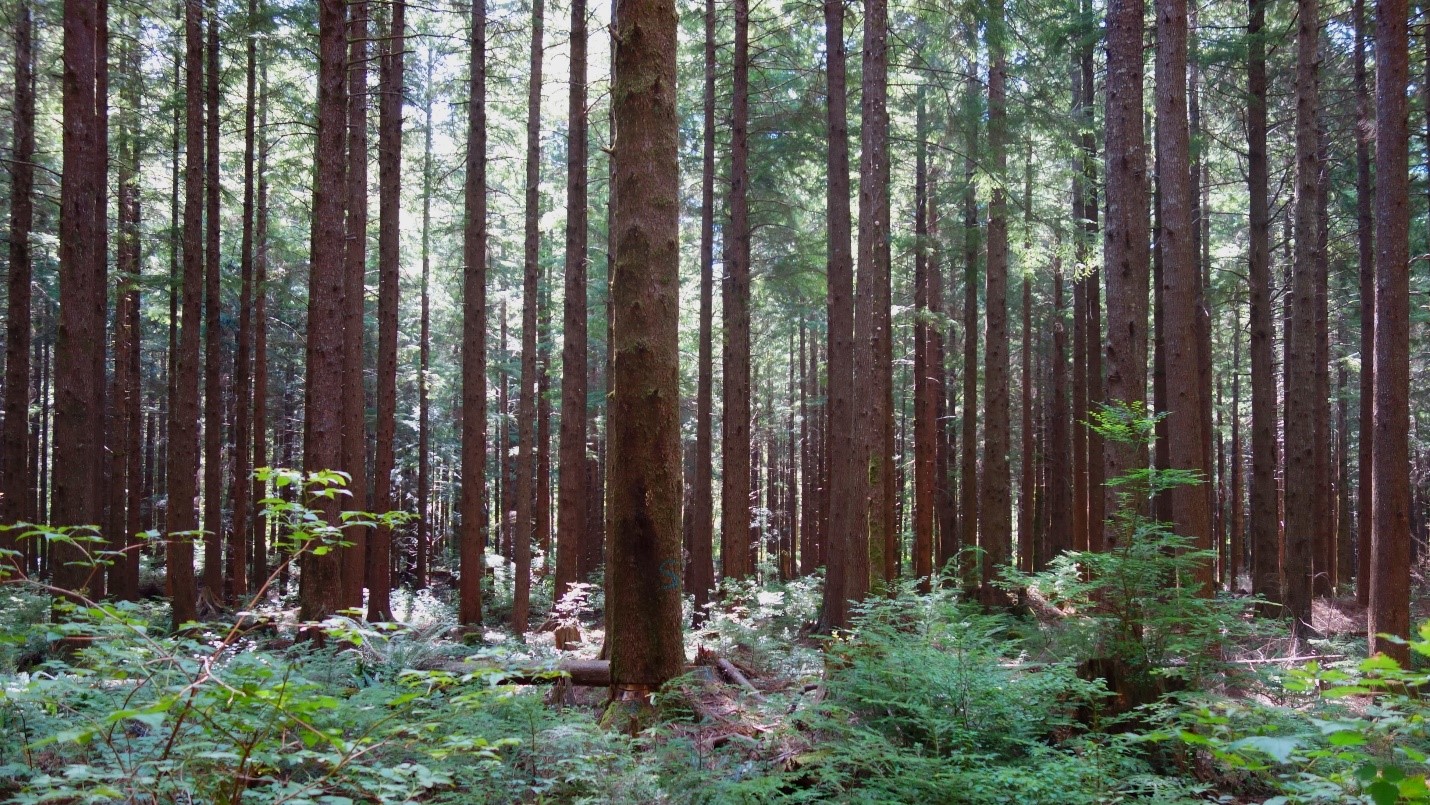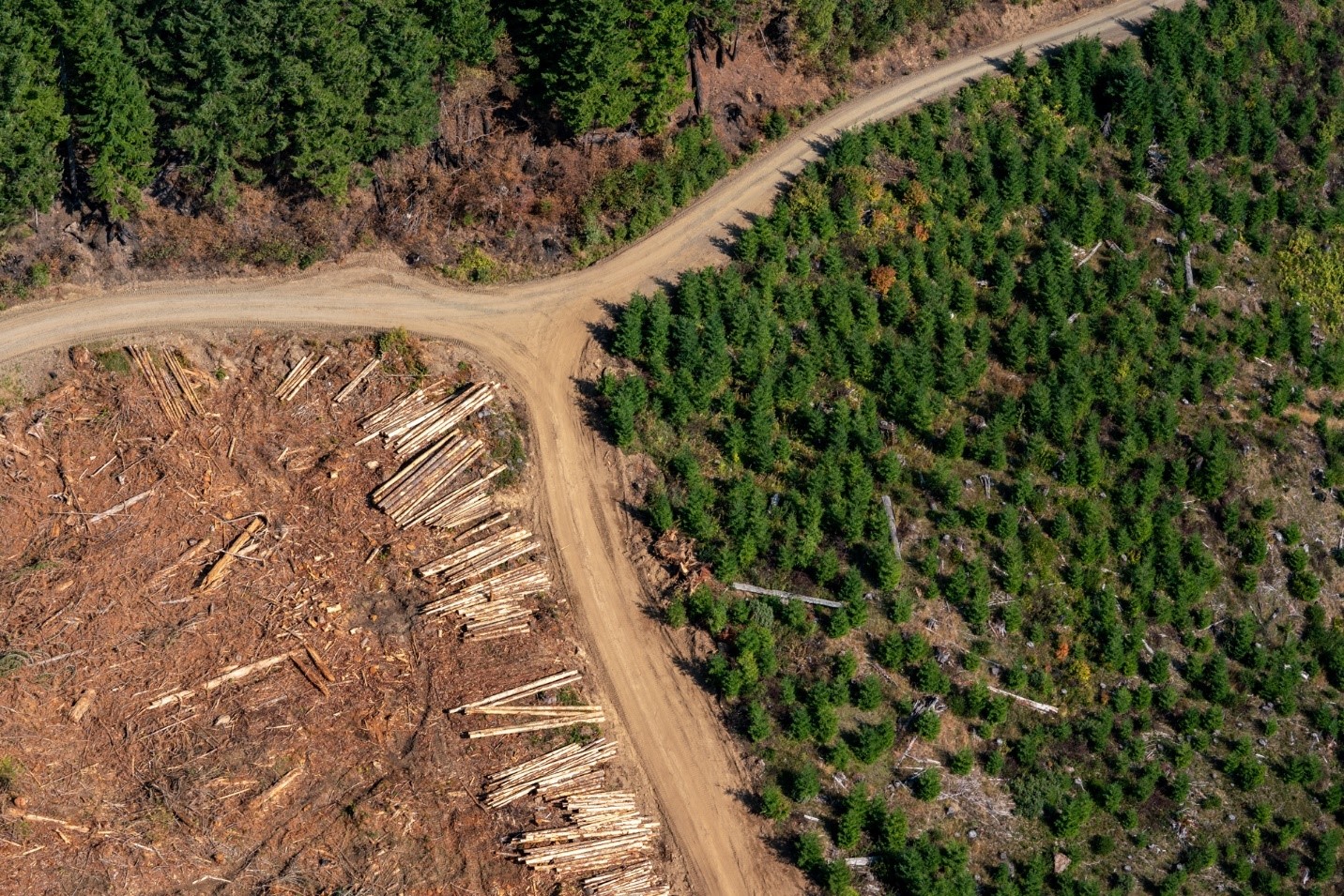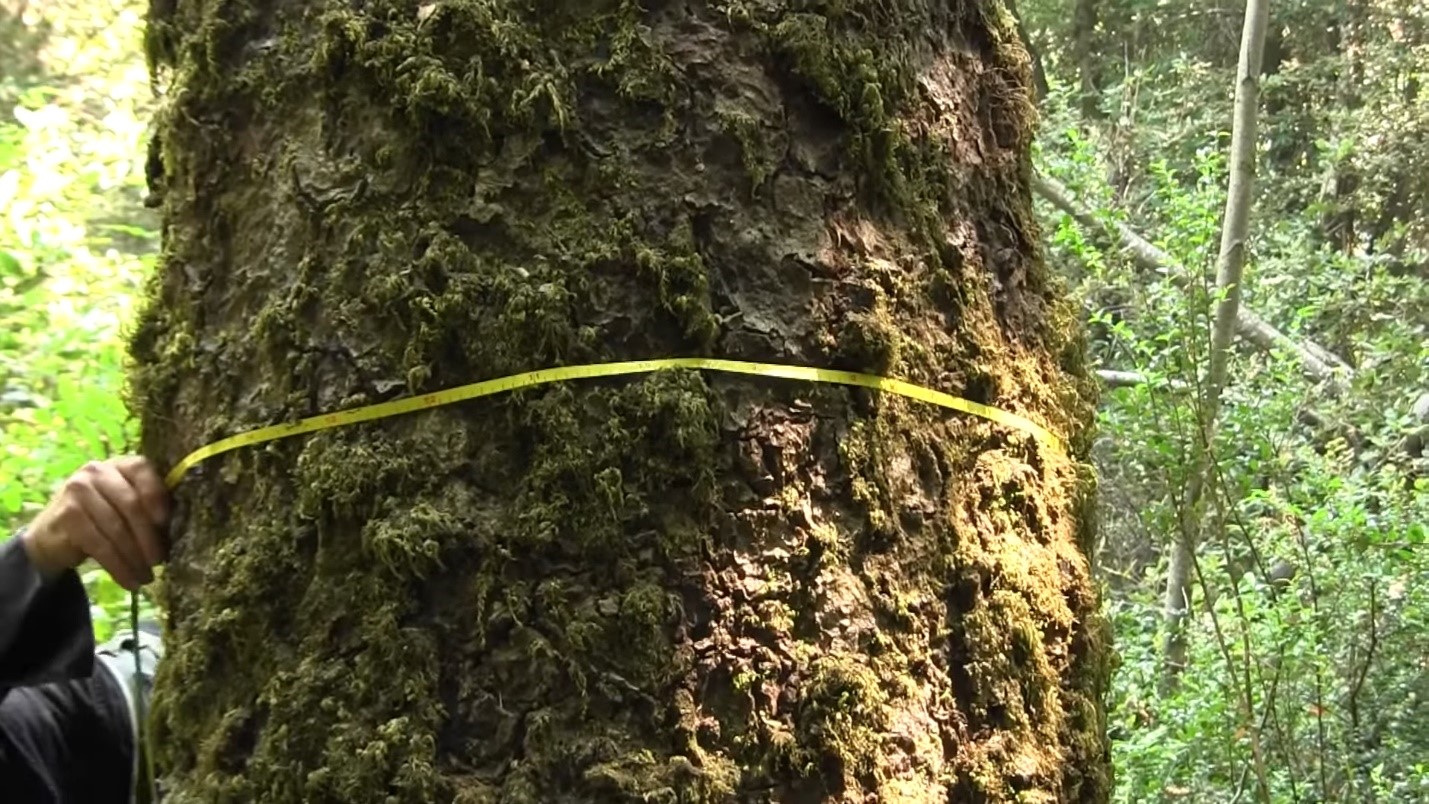Long Rotations for Cascadian Forests
Benefits, barriers and financial viability of letting forests grow older
“Long rotations” refers to delaying logging and growing forests past a short life, letting them reach something closer to what’s sometimes called the “biological growth maximum,” which is the age that yields the greatest volume of timber from the land over time.
In this series, Sightline senior researcher Kate Anderson describes how long rotations can deliver not just greater timber yields, but also greater carbon storage and water and habitat benefits. She also details the barriers foresters face in trying to make the switch from the typical 40-year rotation to a longer 80-year harvest cycle. Finally, she examines how to financially support long rotations—both for the foresters’ sake and for the environmental service benefits that older forests furnish for all who call Cascadia home.
Research & Analysis
Seven Ways to Pay for Long Rotations
Northwest Carbon Markets Can’t Support Longer Timber Harvest Rotations
Why Do We Choose Short Rotation Forestry Over Carbon Storage, Timber Supply, and Forest Health?
Yes, Long Rotations Can Yield Real Climate Gains for Cascadia
Forestry Rotations

Harvesting trees at 80 years, instead of 40, stores more carbon and yields more timber. That’s the takeaway from this first piece examining the prospect of long rotations for Cascadian forests. What’s more, the long-lived moist forests of the Pacific Northwest offer some of the greatest returns for longer rotations. In NFL terms, they are the Tom Brady and Warren Moons of the world’s forests—older, wiser, and winners.
In this article, we:
- profile foresters already practicing—and profiting from—long rotations,
- break down the math of greater timber yields and carbon storage under this model, and
- detail additional benefits for water retention, soil health, wildlife habitat and more.

So why do foresters still use short rotation forestry, despite all the long rotations benefits discussed above? We describe the four main hurdles to foresters adopting longer harvest cycles:
- A short “financial rotation age”: Long rotations produce sustained value over time, but not the short-term return on investment sought especially by investor-driven companies that bought up US forestlands starting in the 1980s.
- Limited mill infrastructure: Long rotations grow large, typically higher-quality logs, but most mills today specialize in small logs and either refuse large-diameter logs or pay less for them.
- Endangered Species Act: The historic loss of Pacific Northwest old-growth means long rotation forests provide rare habitat. Forest landowners worry that inviting in the spotted owl could mean they can’t log their trees.
- Supply: Long rotations produce more timber per year than short rotations, but timberland owners fear that extending their rotations could cause a 15- to 30-year supply shortage that threatens jobs and raises lumber prices.

If foresters decide they want to make the switch from short to long rotations, how can they pay for it? Could those great new carbon markets they’ve been hearing so much about do the trick? Unfortunately, no.
In this article, we describe the limitations of carbon markets to finance the transition from short to long rotations. Specifically, we find:
- Despite proponents’ optimism, carbon markets can finance only a tiny fraction of the climate gains offered by extending timber harvest rotations in Oregon and Washington.
- Short-term carbon projects don’t offset emissions that damage the climate for thousands of years. Guaranteeing long rotations in perpetuity through prescriptive working forest conservation easements is a better deal.
- To weed out “ghost credits” that lower the price of carbon and provide no real carbon gain, forest carbon markets need reform.
- A national cap-and-trade program with mandatory forest enrollment, like New Zealand’s, could solve the problems of scale, impermanence, and ghost credits.
- Still, relying on carbon to fund habitat, water quality, and biodiversity is risky.

Carbon markets aren’t the only means of paying for long rotations, though. Not by a long shot. There are plenty of other mechanisms to help foresters shift to longer harvest cycles, especially given that the (public) ecological benefits from long rotations are often worth double the (private landowners’) costs of delaying harvest.
In this article, we examine the federal and state programs to pay landowners are already in place in the US and could be scaled up with financial expansion by Congress. Funding working forest conservation easements may be the most affordable and scalable tool, while sustainable sourcing and other market tools help build awareness and supply chain capacity. At scale, extending rotations on millions of private timberland acres will likely require complementary tax code modifications and new protective policies.
Get Farms + Forests program updates
Sign up for our monthly newsletter, and follow Sightline’s Farms + Forest Senior Researcher, Kate Anderson, on X.
Subscribe[vc_row][vc_column css_animation=”fadeIn” css=”.vc_custom_1662761950098{background-image: url(https://www.sightline.org/wp-content/uploads/2020/12/rays-through-the-forest-fog_t20_v3BQo3-scaled.jpg?id=79619) !important;background-position: center !important;background-repeat: no-repeat !important;background-size: cover !important;}”][vc_raw_html]JTNDc3R5bGUlM0UlMEElMEFzcGFuLnRleHQlN0Jjb2xvciUzQSUyMGJsYWNrJTNCJTBBYmFja2dyb3VuZC1jb2xvciUzQSUyMHdoaXRlJTNCJTBBYm94LXNoYWRvdyUzQSUyMDEwcHglMjAwJTIwMHB4JTIwMHB4JTIwd2hpdGUlMkMlMjAtMTBweCUyMDAlMjAwcHglMjAwcHglMjB3aGl0ZSUzQiUwQWxpbmUtaGVpZ2h0JTNBJTIwMTMyJTI1JTNCJTBBJTdEJTBBJTBBJTQwbWVkaWElMjBzY3JlZW4lMjBhbmQlMjAlMjhtaW4td2lkdGglM0ElMjA2MDFweCUyOSUyMCU3QiUwQXNwYW4udGV4dCU3QiUwQWZvbnQtc2l6ZSUzQSUyMDE0MCUyNSUzQiUwQSU3RCUwQSU3RCUwQSU0MG1lZGlhJTIwc2NyZWVuJTIwYW5kJTIwJTI4bWF4LXdpZHRoJTNBJTIwNjAwcHglMjklMjAlN0IlMEFzcGFuLnRleHQlN0IlMEFmb250LXNpemUlM0ElMjAxOHB4JTNCJTBBJTdEJTNDJTJGc3R5bGUlM0U=[/vc_raw_html][vc_empty_space height=”275″][vc_column_text css_animation=”fadeIn”]
Long Rotations for Cascadian Forests
[/vc_column_text][vc_empty_space][/vc_column][/vc_row]
[vc_row equal_height=”yes”][vc_column width=”3/5″][vc_empty_space height=”48px”][vc_column_text]“Long rotations” refers to delaying logging and growing forests past a short life, letting them reach something closer to what’s sometimes called the “biological growth maximum,” which is the age that yields the greatest volume of timber from the land over time.
In this series, Sightline senior researcher Kate Anderson describes how long rotations can deliver not just greater timber yields, but also greater carbon storage and water and habitat benefits. She also details the barriers foresters face in trying to make the switch from the typical 40-year rotation to a longer 80-year harvest cycle. Finally, she examines how to financially support long rotations—both for the foresters’ sake and for the environmental service benefits that older forests furnish for all who call Cascadia home.[/vc_column_text][/vc_column][vc_column width=”2/5″][vc_empty_space][vc_raw_html]JTNDZGl2JTIwb25jbGljayUzRCUyMnRoaXMubmV4dEVsZW1lbnRTaWJsaW5nLnN0eWxlLmRpc3BsYXklM0QlMjdibG9jayUyNyUzQiUyMHRoaXMuc3R5bGUuZGlzcGxheSUzRCUyN25vbmUlMjclMjIlM0UlMEElMjAlMjAlMjAlM0NpbWclMjBzcmMlM0QlMjJodHRwcyUzQSUyRiUyRnd3dy5zaWdodGxpbmUub3JnJTJGd3AtY29udGVudCUyRnVwbG9hZHMlMkYyMDIzJTJGMDYlMkZmb3Jlc3RfeXRfc2NyZWVuLnBuZyUyMiUyMHN0eWxlJTNEJTIyY3Vyc29yJTNBcG9pbnRlciUyMiUyMCUyRiUzRSUwQSUzQyUyRmRpdiUzRSUwQSUzQ2RpdiUyMHN0eWxlJTNEJTIyZGlzcGxheSUzQW5vbmUlMjIlM0UlMEElMjAlMjAlMjAlM0NpZnJhbWUlMjBoZWlnaHQlM0QlMjIzMDAlMjIlMjBzcmMlM0QlMjJodHRwcyUzQSUyRiUyRnd3dy55b3V0dWJlLmNvbSUyRmVtYmVkJTJGZ2VyQW1PSUZyUUUlMjIlMjB0aXRsZSUzRCUyMllvdVR1YmUlMjB2aWRlbyUyMHBsYXllciUyMiUyMGZyYW1lYm9yZGVyJTNEJTIyMCUyMiUyMGFsbG93JTNEJTIyYWNjZWxlcm9tZXRlciUzQiUyMGF1dG9wbGF5JTNEMSUzQiUyMGNsaXBib2FyZC13cml0ZSUzQiUyMGVuY3J5cHRlZC1tZWRpYSUzQiUyMGd5cm9zY29wZSUzQiUyMHBpY3R1cmUtaW4tcGljdHVyZSUzQiUyMHdlYi1zaGFyZSUyMiUyMGFsbG93ZnVsbHNjcmVlbiUzRSUzQyUyRmlmcmFtZSUzRSUzQyUyRmRpdiUzRSUwQSUzQ3N1cCUzRSUzQ2VtJTNFS2F0ZSUyMEFuZGVyc29uJTIwcHJlc2VudGVkJTIwaW4lMjBNYXJjaCUyQyUyMDIwMjMlMjB0byUyMHRoZSUyME9yZWdvbiUyMEJvYXJkJTIwb2YlMjBGb3Jlc3RyeSUyMG9uJTIwdGhlJTIwcHJvbWlzZSUyMGFuZCUyMGNoYWxsZW5nZXMlMjBvZiUyMGxvbmclMjByb3RhdGlvbnMlMjBmb3Jlc3RyeSUyMHByYWN0aWNlcy4lMjAlM0NhJTIwaHJlZiUzRCUyMmh0dHBzJTNBJTJGJTJGd3d3LnlvdXR1YmUuY29tJTJGZW1iZWQlMkZnZXJBbU9JRnJRRSUzRnN0YXJ0JTNEMTI3MzVzJTI2YW1wJTNCZW5kJTNEMTcxNzklMjIlMjB0YXJnZXQlM0QlMjJfYmxhbmslMjIlMjByZWwlM0QlMjJub29wZW5lciUyMiUyMGRhdGEtc2FmZXJlZGlyZWN0dXJsJTNEJTIyaHR0cHMlM0ElMkYlMkZ3d3cuZ29vZ2xlLmNvbSUyRnVybCUzRnElM0RodHRwcyUzQSUyRiUyRnd3dy55b3V0dWJlLmNvbSUyRmVtYmVkJTJGZ2VyQW1PSUZyUUUlM0ZzdGFydCUyNTNEMTI3MzVzJTI1MjZlbmQlMjUzRDE3MTc5JTI2YW1wJTNCc291cmNlJTNEZ21haWwlMjZhbXAlM0J1c3QlM0QxNjc5NzczMzQ3NDU5MDAwJTI2YW1wJTNCdXNnJTNEQU92VmF3M010dXc3SzR6dEtWX2pIeGsyeUw1UCUyMiUzRVNlZSUyMHRoZSUyMHZpZGVvJTIwb2YlMjBoZXIlMjBwcmVzZW50YXRpb24lM0MlMkZhJTNFJTIwJTI4c3RhcnRpbmclMjBhdCUyMDMlMjBob3VycyUyMGFuZCUyMDMwJTIwbWludXRlcyUyOS4lM0MlMkZlbSUzRSUzQyUyRnN1cCUzRQ==[/vc_raw_html][/vc_column][/vc_row]
[vc_row][vc_column][vc_tta_tour style=”modern” controls_size=”sm” active_section=”1″ css_animation=”fadeIn”][vc_tta_section title=”1. Long Rotations: The Math Shows More Timber and More Carbon Storage” tab_id=”1654707221039-f5c5a8de-8652″][vc_row_inner][vc_column_inner][vc_column_text]Harvesting trees at 80 years, instead of 40, stores more carbon and yields more timber. That’s the takeaway from this first piece examining the prospect of long rotations for Cascadian forests. What’s more, the long-lived moist forests of the Pacific Northwest offer some of the greatest returns for longer rotations. In NFL terms, they are the Tom Brady and Warren Moons of the world’s forests—older, wiser, and winners.
In this article, we:
- profile foresters already practicing—and profiting from—long rotations,
- break down the math of greater timber yields and carbon storage under this model, and
- detail additional benefits for water retention, soil health, wildlife habitat and more.
[/vc_column_text][vc_btn title=”Read more here” color=”info” align=”center” button_block=”true” link=”url:https%3A%2F%2Fsightline.my-sandbox.xyz%2F2022%2F03%2F17%2Fyes-long-rotations-can-yield-real-climate-gains-for-cascadia%2F|target:_blank”][vc_single_image source=”external_link” alignment=”center” onclick=”custom_link” img_link_target=”_blank” custom_src=”https://www.sightline.org/wp-content/uploads/2022/03/forest_rotation_feature.jpg” caption=”This stand of western hemlock on the Olympic Peninsula was thinned over a decade ago by EFM. Source: EFM.” link=”https://www.sightline.org/2022/03/17/yes-long-rotations-can-yield-real-climate-gains-for-cascadia/”][/vc_column_inner][/vc_row_inner][/vc_tta_section][vc_tta_section title=”2. Short Rotations: Why Foresters Still Use Them Despite Their Drawbacks” tab_id=”1631031119073-d451a2d2-0d89″][vc_row_inner][vc_column_inner][vc_column_text]So why do foresters still use short rotation forestry, despite all the long rotations benefits discussed above? We describe the four main hurdles to foresters adopting longer harvest cycles:
- A short “financial rotation age”: Long rotations produce sustained value over time, but not the short-term return on investment sought especially by investor-driven companies that bought up US forestlands starting in the 1980s.
- Limited mill infrastructure: Long rotations grow large, typically higher-quality logs, but most mills today specialize in small logs and either refuse large-diameter logs or pay less for them.
- Endangered Species Act: The historic loss of Pacific Northwest old-growth means long rotation forests provide rare habitat. Forest landowners worry that inviting in the spotted owl could mean they can’t log their trees.
- Supply: Long rotations produce more timber per year than short rotations, but timberland owners fear that extending their rotations could cause a 15- to 30-year supply shortage that threatens jobs and raises lumber prices.
[/vc_column_text][vc_btn title=”Read more here” color=”info” align=”center” button_block=”true” link=”url:https%3A%2F%2Fsightline.my-sandbox.xyz%2F2022%2F05%2F26%2Fwhy-do-we-choose-short-rotation-forestry-over-carbon-storage-timber-supply-and-forest-health%2F|target:_blank”][vc_single_image source=”external_link” alignment=”center” onclick=”custom_link” img_link_target=”_blank” custom_src=”https://www.sightline.org/wp-content/uploads/2022/05/rotations_2_feature.jpg” caption=”Three stands meet in the foothills of the Cascade Mountains in Oregon: a fresh cut, a young stand, and an adolescent stand (Source: Marcus Kauffman, OR Dept. of Forestry).” link=”https://www.sightline.org/2022/05/26/why-do-we-choose-short-rotation-forestry-over-carbon-storage-timber-supply-and-forest-health/”][/vc_column_inner][/vc_row_inner][/vc_tta_section][vc_tta_section title=”3. Paying for Long Rotations: Unfortunately, Northwest Carbon Markets Can’t Do the Job” tab_id=”1631030966392-6d9b923a-d4b9″][vc_row_inner][vc_column_inner][vc_column_text]If foresters decide they want to make the switch from short to long rotations, how can they pay for it? Could those great new carbon markets they’ve been hearing so much about do the trick? Unfortunately, no.
In this article, we describe the limitations of carbon markets to finance the transition from short to long rotations. Specifically, we find:
- Despite proponents’ optimism, carbon markets can finance only a tiny fraction of the climate gains offered by extending timber harvest rotations in Oregon and Washington.
- Short-term carbon projects don’t offset emissions that damage the climate for thousands of years. Guaranteeing long rotations in perpetuity through prescriptive working forest conservation easements is a better deal.
- To weed out “ghost credits” that lower the price of carbon and provide no real carbon gain, forest carbon markets need reform.
- A national cap-and-trade program with mandatory forest enrollment, like New Zealand’s, could solve the problems of scale, impermanence, and ghost credits.
- Still, relying on carbon to fund habitat, water quality, and biodiversity is risky.
[/vc_column_text][vc_btn title=”Read more here” color=”info” align=”center” button_block=”true” link=”url:https%3A%2F%2Fsightline.my-sandbox.xyz%2F2022%2F07%2F11%2Fnorthwest-carbon-markets-cant-support-longer-timber-harvest-rotations%2F|target:_blank”][vc_single_image source=”external_link” alignment=”center” onclick=”custom_link” img_link_target=”_blank” custom_src=”https://www.sightline.org/wp-content/uploads/2022/07/rotations_feat.jpg” caption=”A third-party carbon verifier measures tree girth for a Northern California carbon project. Source: California Air Resources Board.” link=”https://www.sightline.org/2022/07/11/northwest-carbon-markets-cant-support-longer-timber-harvest-rotations/”][/vc_column_inner][/vc_row_inner][/vc_tta_section][vc_tta_section title=”4. Paying for Long Rotations: Seven Ways We Can Support Extended Harvest Cycles” tab_id=”1631031261889-e429ba45-3817″][vc_row_inner][vc_column_inner][vc_column_text]Carbon markets aren’t the only means of paying for long rotations, though. Not by a long shot. There are plenty of other mechanisms to help foresters shift to longer harvest cycles, especially given that the (public) ecological benefits from long rotations are often worth double the (private landowners’) costs of delaying harvest.
In this article, we examine the federal and state programs to pay landowners are already in place in the US and could be scaled up with financial expansion by Congress. Funding working forest conservation easements may be the most affordable and scalable tool, while sustainable sourcing and other market tools help build awareness and supply chain capacity. At scale, extending rotations on millions of private timberland acres will likely require complementary tax code modifications and new protective policies. [/vc_column_text][vc_btn title=”Read the full article here” color=”info” align=”center” button_block=”true” link=”url:https%3A%2F%2Fsightline.my-sandbox.xyz%2F2022%2F09%2F12%2Fseven-ways-to-pay-for-long-rotations%2F|target:_blank”][vc_single_image source=”external_link” alignment=”center” onclick=”custom_link” img_link_target=”_blank” custom_src=”https://www.sightline.org/wp-content/uploads/2022/09/rotations4_feat.jpg” caption=”Once on the verge of intensive logging and development, former SDS Lumber Company lands in southwest Washington are now protected by working forest conservation easements. Source: @ianshivephoto / @tandemstock” link=”https://www.sightline.org/2022/09/12/seven-ways-to-pay-for-long-rotations/”][/vc_column_inner][/vc_row_inner][/vc_tta_section][/vc_tta_tour][/vc_column][/vc_row]
[vc_row][vc_column][vc_separator][/vc_column][/vc_row][vc_row][vc_column][vc_raw_html]JTNDJTIxLS0lMjBCZWdpbiUyME1haWxjaGltcCUyMFNpZ251cCUyMEZvcm0lMjAtLSUzRSUwQSUzQ2xpbmslMjBocmVmJTNEJTIyJTJGJTJGY2RuLWltYWdlcy5tYWlsY2hpbXAuY29tJTJGZW1iZWRjb2RlJTJGaG9yaXpvbnRhbC1zbGltLTEwXzcuY3NzJTIyJTIwcmVsJTNEJTIyc3R5bGVzaGVldCUyMiUyMHR5cGUlM0QlMjJ0ZXh0JTJGY3NzJTIyJTNFJTBBJTNDc3R5bGUlMjB0eXBlJTNEJTIydGV4dCUyRmNzcyUyMiUzRSUwQSUwOSUyM21jX2VtYmVkX3NpZ251cCU3QmJhY2tncm91bmQlM0ElMjNmZmYlM0IlMjBjbGVhciUzQWxlZnQlM0IlMjBmb250JTNBMTRweCUyMEhlbHZldGljYSUyQ0FyaWFsJTJDc2Fucy1zZXJpZiUzQiUyMHdpZHRoJTNBMTAwJTI1JTNCJTdEJTBBJTA5JTJGJTJBJTIwQWRkJTIweW91ciUyMG93biUyME1haWxjaGltcCUyMGZvcm0lMjBzdHlsZSUyMG92ZXJyaWRlcyUyMGluJTIweW91ciUyMHNpdGUlMjBzdHlsZXNoZWV0JTIwb3IlMjBpbiUyMHRoaXMlMjBzdHlsZSUyMGJsb2NrLiUwQSUwOSUyMCUyMCUyMFdlJTIwcmVjb21tZW5kJTIwbW92aW5nJTIwdGhpcyUyMGJsb2NrJTIwYW5kJTIwdGhlJTIwcHJlY2VkaW5nJTIwQ1NTJTIwbGluayUyMHRvJTIwdGhlJTIwSEVBRCUyMG9mJTIweW91ciUyMEhUTUwlMjBmaWxlLiUyMCUyQSUyRiUwQSUzQyUyRnN0eWxlJTNFJTBBJTNDZGl2JTIwaWQlM0QlMjJtY19lbWJlZF9zaWdudXAlMjIlM0UlMEElM0Nmb3JtJTIwYWN0aW9uJTNEJTIyaHR0cHMlM0ElMkYlMkZzaWdodGxpbmUudXMyLmxpc3QtbWFuYWdlLmNvbSUyRnN1YnNjcmliZSUyRnBvc3QlM0Z1JTNENjhmNDU5MzQxZjRmNmExODcyMTg5ZDQyYSUyNmFtcCUzQmlkJTNEM2UxYjBmNzNhYyUyMiUyMG1ldGhvZCUzRCUyMnBvc3QlMjIlMjBpZCUzRCUyMm1jLWVtYmVkZGVkLXN1YnNjcmliZS1mb3JtJTIyJTIwbmFtZSUzRCUyMm1jLWVtYmVkZGVkLXN1YnNjcmliZS1mb3JtJTIyJTIwY2xhc3MlM0QlMjJ2YWxpZGF0ZSUyMiUyMHRhcmdldCUzRCUyMl9ibGFuayUyMiUyMG5vdmFsaWRhdGUlM0UlMEElMjAlMjAlMjAlMjAlM0NkaXYlMjBpZCUzRCUyMm1jX2VtYmVkX3NpZ251cF9zY3JvbGwlMjIlM0UlMEElMDklM0NsYWJlbCUyMGZvciUzRCUyMm1jZS1FTUFJTCUyMiUzRVN0YXklMjBpbmZvcm1lZC4lMjBTaWduJTIwdXAlMjB0byUyMGxlYXJuJTIwbW9yZSUyMGFib3V0JTIwdGhlJTIwbGF0ZXN0JTIwcmVzZWFyY2glM0MlMkZsYWJlbCUzRSUwQSUwOSUzQ2lucHV0JTIwdHlwZSUzRCUyMmVtYWlsJTIyJTIwdmFsdWUlM0QlMjIlMjIlMjBuYW1lJTNEJTIyRU1BSUwlMjIlMjBjbGFzcyUzRCUyMmVtYWlsJTIyJTIwaWQlM0QlMjJtY2UtRU1BSUwlMjIlMjBwbGFjZWhvbGRlciUzRCUyMmVtYWlsJTIwYWRkcmVzcyUyMiUyMHJlcXVpcmVkJTNFJTBBJTIwJTIwJTIwJTIwJTNDJTIxLS0lMjByZWFsJTIwcGVvcGxlJTIwc2hvdWxkJTIwbm90JTIwZmlsbCUyMHRoaXMlMjBpbiUyMGFuZCUyMGV4cGVjdCUyMGdvb2QlMjB0aGluZ3MlMjAtJTIwZG8lMjBub3QlMjByZW1vdmUlMjB0aGlzJTIwb3IlMjByaXNrJTIwZm9ybSUyMGJvdCUyMHNpZ251cHMtLSUzRSUwQSUyMCUyMCUyMCUyMCUzQ2RpdiUyMHN0eWxlJTNEJTIycG9zaXRpb24lM0ElMjBhYnNvbHV0ZSUzQiUyMGxlZnQlM0ElMjAtNTAwMHB4JTNCJTIyJTIwYXJpYS1oaWRkZW4lM0QlMjJ0cnVlJTIyJTNFJTNDaW5wdXQlMjB0eXBlJTNEJTIydGV4dCUyMiUyMG5hbWUlM0QlMjJiXzY4ZjQ1OTM0MWY0ZjZhMTg3MjE4OWQ0MmFfM2UxYjBmNzNhYyUyMiUyMHRhYmluZGV4JTNEJTIyLTElMjIlMjB2YWx1ZSUzRCUyMiUyMiUzRSUzQyUyRmRpdiUzRSUwQSUyMCUyMCUyMCUyMCUzQ2RpdiUyMGNsYXNzJTNEJTIyY2xlYXIlMjIlM0UlM0NpbnB1dCUyMHR5cGUlM0QlMjJzdWJtaXQlMjIlMjB2YWx1ZSUzRCUyMlN1YnNjcmliZSUyMiUyMG5hbWUlM0QlMjJzdWJzY3JpYmUlMjIlMjBpZCUzRCUyMm1jLWVtYmVkZGVkLXN1YnNjcmliZSUyMiUyMGNsYXNzJTNEJTIyYnV0dG9uJTIyJTNFJTNDJTJGZGl2JTNFJTBBJTIwJTIwJTIwJTIwJTNDJTJGZGl2JTNFJTBBJTNDJTJGZm9ybSUzRSUwQSUzQyUyRmRpdiUzRSUwQSUwQSUzQyUyMS0tRW5kJTIwbWNfZW1iZWRfc2lnbnVwLS0lM0U=[/vc_raw_html][/vc_column][/vc_row]
